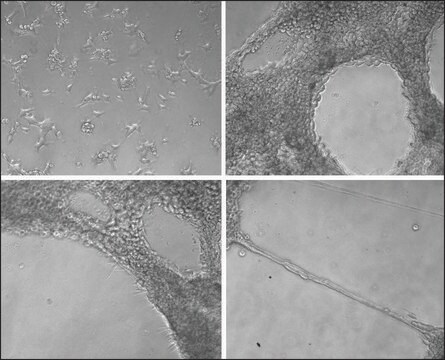ECM205
Kit di screening ECM Millicoat®, 1 pz. ECM101-ECM105
Millicoat®, pkg of 96-well plate(s) (for fibronectin, vitronectin, laminin, collagen I & collagen IV)
Sinonimo/i:
Formerly under the CytoMatrix brand name.
About This Item
Prodotti consigliati
Reattività contro le specie
human
Livello qualitativo
Produttore/marchio commerciale
Chemicon®
Millicoat®
Confezionamento
pkg of 96-well plate(s) (for fibronectin, vitronectin, laminin, collagen I & collagen IV)
tecniche
activity assay: suitable
cell based assay: suitable
input
sample type neural stem cell(s)
sample type: human embryonic stem cell(s)
sample type: mouse embryonic stem cell(s)
sample type epithelial cells
sample type hematopoietic stem cell(s)
sample type pancreatic stem cell(s)
sample type induced pluripotent stem cell(s)
sample type mesenchymal stem cell(s)
Metodo di rivelazione
colorimetric
Condizioni di spedizione
wet ice
Descrizione generale
Applicazioni
Struttura cellulare
NOTA: Le prestazioni ottimali del test si ottengono utilizzando colture cellulari subconfluenti. Questo risultato può essere ottenuto dividendo le cellule da 1 a 2 giorni prima dell'esecuzione del test.
1. Reidratare le strisce con 200 mL di PBS per pozzetto per almeno 15 minuti a temperatura ambiente. Rimuovere il PBS dalle strisce reidratate.
2. Preparare una sospensione monocellulare, preferibilmente utilizzando un tampone di dissociazione non enzimatico. La densità cellulare ottimale può essere determinata mediante titolazione delle cellule. Un intervallo di partenza comune è compreso tra 1x10E05 e 1x10E07 cellule/mL.
3. Aggiungere 100 mL della sospensione cellulare diluita in ogni pozzetto. Incubare la piastra per 37 °C per 1 ora nell'incubatore a CO2. Lavare delicatamente la piastra 3 volte con PBS contenente Ca2+/Mg2+ (200 mL/pozzetto).
4. Aggiungere 100 mL di cristalvioletto allo 0,2% in etanolo al 10% in ogni pozzetto. Incubare per 5 minuti a temperatura ambiente. Rimuovere il colorante dai pozzetti. Lavare delicatamente la piastra 3 volte con PBS (300 mL/pozzetto).
5. Aggiungere 100 mL di tampone di solubilizzazione (una miscela 50/50 di NaH2PO4 0,1M a pH 4,5 e 50% di etanolo) a ciascun pozzetto. Lasciare incubare le strisce e agitare delicatamente a temperatura ambiente fino alla completa solubilizzazione del colorante legato alle cellule; ci vorranno circa 5 minuti.
6. Determinare l'assorbanza a 540 - 570 nm utilizzando un lettore di micropiastre.
Stoccaggio e stabilità
Note legali
Esclusione di responsabilità
Codice della classe di stoccaggio
11 - Combustible Solids
Certificati d'analisi (COA)
Cerca il Certificati d'analisi (COA) digitando il numero di lotto/batch corrispondente. I numeri di lotto o di batch sono stampati sull'etichetta dei prodotti dopo la parola ‘Lotto’ o ‘Batch’.
Possiedi già questo prodotto?
I documenti relativi ai prodotti acquistati recentemente sono disponibili nell’Archivio dei documenti.
Articoli
Extracellular matrix proteins such as laminin, collagen, and fibronectin can be used as cell attachment substrates in cell culture.
Contenuto correlato
This page covers the ECM coating protocols developed for four types of ECMs on Millicell®-CM inserts, Collagen Type 1, Fibronectin, Laminin, and Matrigel.
Il team dei nostri ricercatori vanta grande esperienza in tutte le aree della ricerca quali Life Science, scienza dei materiali, sintesi chimica, cromatografia, discipline analitiche, ecc..
Contatta l'Assistenza Tecnica.






